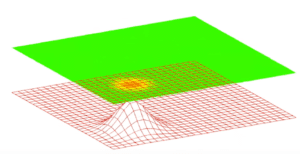In quantum mechanics, when physicists measure a property of a quantum particle, like a photon, they are really saying that they detect one of its properties. The key to understanding why “measurement” is of such consequence in the quantum world is understanding that detection creates a fundamental change in a particle’s condition.
For example, let’s take the detection of a photon. Here’s a highly simplified experiment: we hold an extremely dim lamp in front of a photographic plate. It’s so dim that it emits only one photon at a time. The photon exposes the plate in one spot and makes a mark there. Once the photon hits the plate, we know the position of the photon—it’s a certain distance from each edge of the plate. So, we have detected it and, specifically, we have detected its position. Quantum physicists would say that we have “measured” its position.
This might seem just like measuring anything in the macroscopic world. For example, let’s say that a biologist uses a microscope to detect the position of a living bacterium in a living human cell on a slide. She measures the distance of the bacterium from each edge of the cell.
Here’s the difference: prior to the biologist measuring the position of the bacterium, the bacterium was happily swimming about the cell. After the measurement, same thing: happily swimming bacterium.
What was the photon doing before the measurement, before it hit the photographic plate? In our physical universe, it wasn’t doing anything because it hadn’t yet made an appearance in our universe.
Measurement converts the particle from a superposition.
So, did the measurement create the photon? No. Prior to hitting the plate, the photon was in a la-la land of being in all possible positions in the photographic plate and maybe elsewhere as well. This condition of being in many possible positions is a “superposition.” A superposition of a particle is a state that we never observe in the physical universe. Have you ever seen an object occupy many positions at the same time? Neither have I. But prior to measurement, the photon was in every possible position that the lamp could have shot it to.
The condition of being in a superposition is also called a “quantum state.” It is the condition in which the weird behavior of quantum mechanics occurs. One way to look at this condition is to see it as a sublevel of reality underlying our everyday physical universe reality. This is how the Transactional Interpretation of quantum mechanics describes the quantum world.

Here’s another example: Imagine you were living the life of a character in a video game and, suddenly, you could see the computer coding that the video game was running on. Both the video game and the underlying coding are real. But they are different levels of reality. I called the quantum level underlying the regular physical universe level, “la-la land.” One of the developers of the Transactional Interpretation, Dr. Ruth Kastner, calls it “Quantumland.” Good name.

The position we will be most likely to detect the particle is the highest point of the wave. As it happens, the photon was measured where it had the highest probability of being measured. Of course, other photons might be found in lower probability positions.
In short, measurement in quantum physics converts a multiplicity of possible states within a sublevel of reality (Quantumland) to a single definite state within physical reality.
These are just words trying to describe equations.
What leads physicists to think that prior to measurement, the photon is in a superposition of many possible locations? This is what the math is saying. The results of experiments on quantum particles can be predicted using mathematical equations. Initially, Shrodinger’s Equation was a key quantum mechanics equation; later, Schrodinger’s was upgraded. Schrodinger’s and later equations which are used to correctly predict quantum behavior, generate only probabilities of possible positions of particles. So, if one runs an experiment repeatedly, the equations correctly predict the percentage of times that the particle will be detected in any particular position. Only when the particle is measured, can it be assigned a unique position. That information appears nowhere in the equations. So, many physicists consider that the equations describe a superposition of states.
I have just outlined the original interpretation of the meaning of Schrodinger’s Equation. This interpretation, which originated in the 1920’s and ’30’s, is called the Copenhagen Interpretation. Many later interpretations retain the view that the quantum particle exists as a superposition prior to measurement. Other interpretations, such as the Bohmian interpretation and Many Worlds Interpretation do not. This Wikipedia article lists the interpretations of quantum mechanics that hold that quantum particles exist in superpositions prior to measurement. These are labeled as involving “collapsing wavefunctions.”
Why take the equations so seriously? Why do our theories of what’s going on have to fit the math? Physicists have the goal of describing physical phenomena with mathematical equations. In fact, they do not honor a description of the world with the label “theory” unless it is a mathematical equation or a set of mathematical equations. It was not sufficient for Einstein to say that matter can convert to energy. That’s not a physics theory. When he wrote E= mc2 , he had written a physics theory. So, physics theories are mathematical statements. The verbiage describing these theories are called “interpretations.” In physics, the interpretations must fit the equations, not the other way around.
